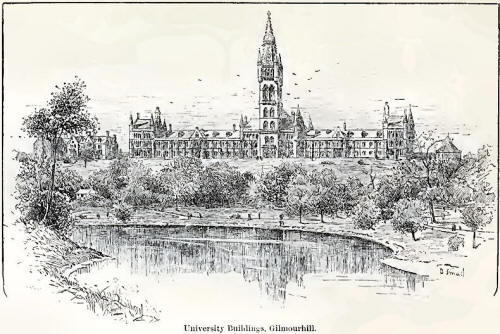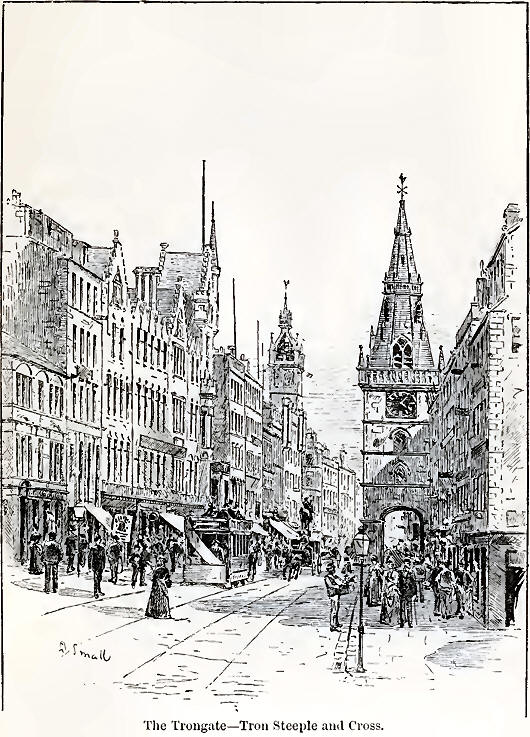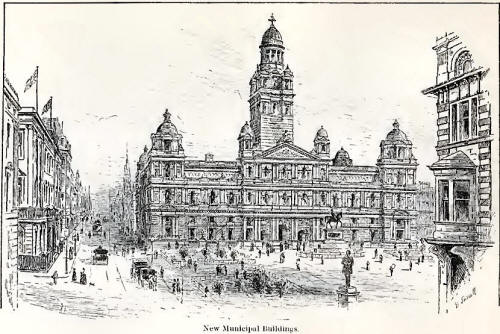|
The Cathedral was founded in 1123, lurinor the reffin
of David I., and was dedicated to St. Mungo. It is situated on the
higher part of the city at the head of High Street, and just above
the banks of the Molendinar stream, where its patron saint
established his humble cell thirteen centuries ago. The Cathedral,
fortunately surviving the destruction of similar buildings about the
time of the Reformation, is still an object of interest to visitors
and of pride to the inhabitants for its pure and early English style
of architecture, its crypt almost unique in its completeness and
extent, and, although a modern decoration, its stained-glass windows
are of such high-class work and artistic design as to be quite in
harmony with the venerable structure, whose gray and sombre
colouring by the hand of Time they serve to brighten with their rich
and many-coloured lights.
Sir Walter Scott gives us in Rob Roy a picture of the
Cathedral and its surroundings as they appeared when “The Mac Gregor”
paid his occasional visits to Glasgow: “ Standing in a populous and
considerable town, this ancient and massive pile has the appearance
of the most sequestered solitude. High walls divide it from the
buildings of the city on one side; on the other it is bounded by a
ravine, at the bottom of which, and invisible to the eye, murmurs a
wandering rivulet, adding by its gentle noise to the imposing
solemnity of the scene.”
At one time the building was divided as follows:—
The Choir, Outer Church, Inner High Church, and
Vaulted Cemetery. Worship was conducted on Sundays in the Outer
Church and the Inner High Church, and for a time in what was called
the Vaulted Cemetery or Crypt; and it is to this lower sanctuary
that we are conducted in the novel referred to, which is described
as “an extensive range of low-browed, dark, and twilight vaults,” in
which a numerous congregation had assembled, and where the hero of
the story hears the whisper, “You arc in danger in this place; meet
me to-night on the Brigg at twelve prececsely;” and giving heed to
this warning he meets Bob Boy, as “the hour of twelve o’clock swung
its summons over the city from the belfry of the Metropolitan Church
of St. Mungo, and was answered and vouched by all the others like
dutiful diocesans.”
The College buildings stood in High Street, but like
many other things they also have had to give way to the changes
which constantly occur in an ever-growing and widening industrial
community. Where once the learned professor and aspiring student met
in yearly session and devoted themselves to the advancement of
learninu' and the cultivation of the mind, there is now little
remaining to mark the site of their former abodes and class-rooms.
The railway passes through them, and the snort of the iron-horse and
his warning whistle echo through the colonnades of the
railway-station which has taken their place. But is it not a fitting
successor to the old halls and class-rooms where James Watt first
made his immortal discovery, which gave the old and inefficient
steam-engine a renewed vitality? As we stand 011 the platform, we
see the locomotive with its train behind, the fire burning brightly
and the steam up to its required pressure, with the electric light
brilliantly showing from the carriage roofs, switched off and on
automatically as the train dives out and in the tunnels driven
beneath the busy streets. We feel that this is the outcome of much
that has been lectured and experimented upon in the classroom and
laboratory of the old buildings. And the names of Black, Watt,
Rankin el and Thomson occur to us as workers in the field of
science, whose investigations in this very place have helped to
bring about these wonderful changes.
The University has now moved west; all modern life
seems to tend westward, and since the time of Columbus we have
pushed still further out into the new fields opening to the
enterprising on the other side of the Atlantic. The new site is much
more prominent than the original one in the High Street, yet no
doubt in the early days the old buildings would be quite as well
marked out, as the city was smaller and distances were not then
reckoned by miles. Various recent endowments by wealthy citizens and
others have contributed to the completion of the present buildings
on Gilmourhill, and to the carrying on more completely the work of
the various chairs. And not only have these benefactions resulted in
the erection of the handsome modern structure, but also in the
re-erecting of the old gateway, with the veritable stones cut by and
bearing the chisel marks of the old builders a couple of centuries
ago, and which once more throws its shadow over the student and
visitor as they pass and repass to class-room and court, as in the
days of old. We can also still pass up and down the old stone
stairway with its guardian lion and unicorn, which was originally
erected in the old college so far back as 1090.
George’s Square, at one time a dismal, railed-in
place, is now opened out to the public, and contains a number of
monuments to distinguished names, combining royalty, war, science,
literature, &c. Sir Walter Scott from his lofty pedestal looks
abroad over the city, whose old-fashioned life and incidents he has
so well portrayed. Sir John Moore, whose death at Corunna is so
dramatically described in the well-known lines:
“We buried him darkly;—at dead of night,
The sods with our bayonets turning;
By the struggling moon-beams’ misty light,
And the lantern dimly burning.”
Sir Colin Campbell, posed alert, and intense with
readiness for action. Graham, the master of the mint, and Watt in
scientific contemplation, Campbell and Burns, Livingstone and Peel,
are all here; the unchanging bronze perpetuating by the magic skill
of the sculptor the personal characteristics of each, while the busy
city life goes on, and we hear arising from the constant murmur of
the streets something like this:
“For men may come and men may go,
But I go on for ever.”
Other statues adorn the city, such as that of the
Duke of Wellington in front of the Exchange, where, mounted on his
faithful charger, the “hero of a hundred fights” appears to be
directing the movement of his troops on the battle-fields, depicted
on the panels below.
Another and an older equestrian statue stands at the
Cross, viz.: that of King William III., and of which the late Rev.
Norman Macleod tells the following story:—
“The traveller who visits Glasgow and takes the
trouble of walkinq- along the Trongate, which would be a fine street
in any city, will notice near the ‘Cross,’ at its eastern extremity,
an equestrian statue of no mean value as a work of art, and he will
also discern two old guns protruding their small rusty muzzles above
the uround at its base. Those "uns blazed at the battle of the
Boyne, and they now look up to King William III., who commanded them
there. Strange to say, this is the only statue in Scotland or
England erected to him of ‘ immortal memory.’ A Latin inscription on
the base of the statue inform us, among other things, that it was
erected in 1734 by ‘Jacobus Macrae, Gubernator Madrasii.’ We may add
that this work of art was the only one of the kind known for more
than a century to the peasantry of the West Highlands. The first
object on reaching Glasgow which the Highlander went to see was the
'black horse;’ and the first question asked of him when he returned
home, by those who wished to hear his news, was, 'Have you seen the
black horse?’”
A number of fine old mansion-houses built by the
mercantile aristocracy of the last century at one time adorned the
city, but are now mostly pulled down or incorporated with new
buildings. One of these is interesting from the fact that it is
built into the front part of the Exchange in Queen Street. This
mansion-house was known as the Lain,straw Mansion; afterwards The
Royal Bank used the upper or drawing-room floor for its business,
and finally, when the Royal Exchange was built in 1829, the old
building was preserved, and the new building, with its fine row of
Corinthian columns, spread out over the old garden ground behind.
The new Municipal Buildings in George Square,
approaching completion, constitute an elaborate and massive pile, in
which the work of the various trusts connected with the municipality
can he carried out, and the magisterial functions of the
representatives of the city can have freer scope in the Council
Chamber. The foundation-stone was laid on (5th October, 18S3J with
all the masonic honours, and Glasgow kept high holiday in honour of
the event, the various trades turning out in their thousands, as the
Glasgow tradesmen love to do on any great occasion, and carrying on
for the edification of their fellow-citizens their various crafts;
working away on stages carried by lorries, drawn by
gaily-caparisoned horses. This great procession, reckoned at about
30,000 strong, headed by the carters mounted on their splendid
Clydesdales, specially decorated for the occasion, made a tour of
the city, and finally converged on the square.

The building is in the Italian Renaissance style, and
occupies a square of about 75 yards on the side, thus covering an
area of about 5600 square yards. There are several stories, the main
walls reaching to a height of 75 feet, having a central tower rising
to a height of 242 feet, of which 225 feet is of masonry, terminated
with 17 feet of ornamental gilded metal work. Besides the Council
Chamber and various offices a large banqueting hall is one of the
features, measuring 110 feet in length by 50 feet wide; the height
of this hall is 50 feet.
In modern building's Glasgow can boast of having the
tallest chimney-stalks in the world. The great stalk at Messrs.
Tennant’s St. Rollox Chemical Works is 455\ feet in height from
foundation to top, or 4351 feet aboveground. Its external diameter
at base on ground-line is 40 feet, with a thickness of 2 feet 74
inches; at top its external diameter is 13 feet G inches, with a
thickness of 1 foot 2 inches. The chimney has a
slightly-curved batter or rate of variation in width.

The chimney at Messrs. Townsend’s Chemical Works,
built 1857, is 4G8 feet high, of which 454 feet is aboveground. An
extra height of ornamental iron work extends for 20 feet above the
cope. The outside diameter at surface of ground is 32 feet, and at
top 12 feet 8 inches; the thickness varies from 7 bricks at base to
11 brick at top. The chimney has a straightbatter.
This great stalk shortly after being finished was
subjected to a severe storm which broke over Glasgow, and in
consequence of the immense pressure of wind upon such a great
surface it was visibly bent over. It became a question how to deal
with it under such conditions, when finally a simple, and, as the
result proved, an effective remedy was suggested, viz. that of
sawing into the joints on the convex side. This was done, and the
great chimney gradually settled back to its originally perpendicular
position.

Up to within a few years ago these great stalks were,
with one or two exceptions (the great spires at Vienna and
Strasburg, and the Great Pyramid), the highest buildings in the
world; but the Americans can now claim to possess a building which
much exceeds previous structures, viz. the Washington Monument at
Washington.
This is an obelisk 555 feet high, built of beautiful
white marble, and which, in the clear air of that city, can be seen
a long distance off. |

